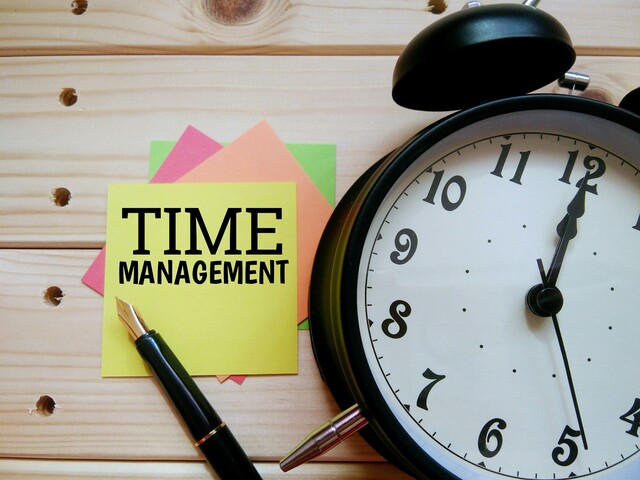Whether you're faced with a client who's simply hoping to neaten up their desk space, or a CEO aiming to attack an entire office (or district), at one point or another, we could all use a little help organizing our businesses. Even professional organizers! That's because there are so many different facets of running a successful business that failing to pay the appropriate amount of attention to just one of them can spell the difference between success and failure. Therefore, it's your job as the professional organizer to aid your clients in properly organizing their business, whether it's a one-man show, or a Fortune 500 company.
Office disorganization takes a toll on productivity, and it also makes workers feel distracted, uncomfortable, and sometimes even guilty.
When it comes to paperwork and files in your office, perhaps the easiest way to gain control is to start out by filing through your papers immediately! Make sure your clients understand that when the mail comes in, they need to go through it quickly, deciding what should be kept and what should be trashed. By getting in the habit of going through the mail as soon as it comes in, your clients will also begin getting into the habit of going through other paperwork that comes across their desk -- before they're completely overwhelmed with piles and piles of papers! Remember the acronym TRAF, which stands for toss, refer, act, file.
When it comes to helping your clients set up their own office filing system, here are a few tips to consider sharing with them:
Clearly label and identify the contents of each and every file
Consider color-coding the file folders. Use one color for financial documents, another for internal memos that need action, and yet another for human resources paperwork, etc.
If part of your client's job involves maintaining several magazines or pamphlets that don't have the name or issue number on the spine, group the materials by title, and label the shelves they are stored on accordingly.
While we briefly touched on some tips for dealing with mail and memos in the previous segment, we're going to pay a little more attention to these areas, if for no other reason than mail and memos are probably crossing your client's desk on a daily basis.
As we said, the first key to dealing with mail and memos is taking care of them daily. Encourage your client to get into this habit - it should take them less than 15 minutes each day to tackle this task, and by doing so they'll be a lot closer to office organization!
To help them accomplish this task, here are a few categories that your client can use to file their mail and memos:
- To Trash
- To Inquire About
- To File
- To Call
- To Do
- To Read
Finally, when it comes to deciding whether to toss or keep a certain item, make sure that your client is asking the right question. The question isn't "Could I possibly need to use this one day?" The question is, "What's the absolute worst thing that could happen if I trashed this?" When the answer is "Nothing," then toss it out!
Computer Files, Software, and Hardware
If your clients constantly find themselves wasting time searching for files on their computer, you can help! The key to gaining control over this area of their lives is learning to view the computer just as they would their desk or filing cabinets. In order to have success, they'll need to have those files organized and easy to find. Here are a few tips you can share with them to help them make it happen:
- Have them get into the habit of cleaning out their hard drive regularly. Be sure that they're on the lookout for files and software programs they no longer use. By doing this, your client will free up valuable space for essential files.
- Organize your files carefully, and clearly label the folders you store documents in. Visit these folders regularly and make sure that they aren't storing any expired or unnecessary documents. If your client isn't sure, have them print and file a hard copy of the document before deleting it.
- Is your client relying on coded files for security purposes? Make sure that they're keeping a list of the codes and the real names somewhere safe where it can easily be accessed as needed.
- Store your client's computer's back-up disks in a safe place, such as a fire box, or with a records management company. That way, in the event of a disaster, their information is still safe and sound.
Contacts and Connections
Keeping up with correspondence can be just as hard in the corporate world as it is at home. Therefore, you need to be prepared to help your clients find new ways to manage their various contacts and connections. Here are a few ideas that should help you to get started:
- Does your client have a hard time keeping up with all of the business cards they've received? First of all, have them sort through the cards they've saved and eliminate any they KNOW they won't need -- as well as any duplicates. With those that remain, transfer them into a small photo album for quick and simple reference. You can either file them alphabetically or according to profession.
- If your client is looking for a simpler way to manage their company address book, consider having them take care of it electronically, on their computer. Using a computerized system will give them the freedom to search for contacts alphabetically, geographically, or by category. And with the added benefit of mail-merge systems, it can save a great deal of time when it comes to personalizing form letters and printing out address labels!
- Whichever address book/contact system your client opts to work with, the most important thing is to keep up with it. Have them set aside a little time each month to go through and update any changes of phone number, address, etc.
Business Libraries
Many companies offer their staff a business library, a place where they can come to improve their learning and understanding of the various aspects of their company, their job function, and being a successful employee. If your client happens to have an office or business library, here are a few tips for helping them keep things in order:
- First of all, take a careful look at their current library filing system. Look for any obvious faults, weaknesses, or missing categories.
- If the client has a small-to-medium-sized library, help them take a complete inventory of their books. Make a list of each title, author, and publisher, as well as which category the work falls under. (For example, is the book under the category of Finances? Motivation? Training?)
- If the client has a large library, have them tackle the project in smaller segments. For instance, on Monday they can inventory the books on the first row of shelves, Tuesday the second, and so on.
- Once you've inventoried the books (and donated any that were past their prime), it's time to devise a set placement of the books. Once this has been done, have your client go back and label each of the book shelves accordingly. Also recommend that they treat their books like any library treats theirs: with respect and foresight. Consider adding a Dewey decimal-type system to help your client's employees have an easier time finding the book they need quickly.
- Finally, make sure that your client creates a clear list of who has what book in their possession, and when they're supposed to turn it back in. You'd be surprised how many employees never return those books they check out!
Dealing With Desk Space
If you were to survey most of your business clients, you'd probably find that their number one struggle with office organization boils down to the constant battle with cluttered desk space. Not only does a messy desk detract from your client's professional image, it causes them to waste valuable time that could have been better spent focusing on other areas of their business. Here are a few techniques to help your clients re-conquer their desk space:
- First of all, if your client has been fighting the clutter bug for most of their lives, the key to making a successful change is time and consistency. Have them address their desk problems in small blocks of time. If you can tell they'll never have the courage (or time) to tackle the task all at once, recommend that they simply devote a few hours a day to the task until the job is done.
- When it comes time to do the organizing, make sure all of the things they'll need are close at hand. This includes a trash can, a pen, filing folders, labels, or any other desk organizational items they require.
- Have them start by completely clearing whatever space they're working to organize. If they're working with the surface of the desk, remove everything from the top of the desk and then begin sorting through each of the items taken down.
- Immediately categorize where papers and files should go and make sure that your client gets them there!
- Once they've accomplished their first major desk renovation, help them schedule in time each day to devote to keeping their desks neat and clean. If necessary, work with other employees at the company to accomplish the same thing!
Setting Up Your Professional Organizing Business
Now that we've covered most of the preliminaries, it's time to start talking more about the specifics of creating your professional organizing practice. There are some fairly important details we still haven't covered yet, and many of the issues you'll find covered in this section are issues that will confront each and every professional organizer there is!
The five areas we're going to focus on in this section are: pricing your services, time management and goal setting, contract facts, bookkeeping, and location.
Pricing Your Services
One of the most difficult challenges for new professional organizers is deciding how to price their services. Until recently, there hasn't been a huge supply of (or demand for) professional organizers. But, today, that has changed. Fortunately, with the aid of your computer and the World Wide Web, you can easily shorten the time and effort you need to expend to research regional pricing guidelines. Simply visit your favorite online yellow pages site (or your favorite professional organizing association or web ring) and perform a proximity search for other professional organizers in your region.
Prior to actually creating your search, you may want to consider establishing a set working radius so that you can better estimate travel times, costs, and target markets.
While you may not find several professional organizers in your area, you should continue to gradually broaden your search until you are able to find at least two or three different professional organizers in your surrounding area (or at the absolute least, the same state) that have a website with hourly rates listed.
Then, consider your own unique selling proposition (or USP). This is also sometimes (mistakenly) called the unique selling point. Basically, it's the main reason(s) that people should hire you as opposed to your competitors. It's what sets you apart from everyone else in your field.
Should you be offering value pricing, or is yours a premium service?
The most effective and all-encompassing way to manage your pricing is to maintain multiple streams of professional organizing income. This can be accomplished by your hourly wage, royalties from books, payouts from affiliate programs, income from your mailing list, seminar registration fees, etc. By offering two (or more) of these different income streams -- especially when it comes to residual income (like royalties) -- you'll be working to slowly but surely ease your work load in the future.
Time Management and Goal Setting
There are two very essential aspects of getting your new business set up that go hand in hand -- time management and goal setting. And any successful professional organizer is going to have their fair share of both! Indeed, some people might argue that, depending upon how you look at it, they are both the same thing.
According to Wikipedia, "Time management teaches a number of techniques that aim to increase the effectiveness of a person in getting the things done that need to be done. Time management is somewhat of a misnomer, as time passes without regard to what we do; the only thing we can manage is ourselves. Hence time management is mostly about self management."
According to this same site, "Goal Setting involves setting a clear objective and ensuring that every participant is clearly aware of what is expected from him or her, if this objective is to be achieved. This has a couple of advantages in that, assuming that the goal is reasonably challenging, all participants will have to put forth a substantial effort to achieve that goal. Second, because every member is aware of what is expected of him or her (high role perception), little room is left of inadequate effort going unnoticed."
Did you notice any similarities between the two concepts?
When it comes to these two principles, there are just three main points that we'd like to stress:
Be sure that as you're delegating your daily tasks and schedule, you create reasonable time -- and deadlines. It's a good idea that as you integrate new activities and practices into your schedule, you time the event the first few times you perform it. This way you can form an average time and allot your time accordingly. This is much more effective than only allowing yourself 15 minutes for a two-hour task, or vice versa. Remember the old proverb, "Don't bite off more than you can chew!" There's no sense in setting yourself up to experience failure.
As much as humanly possible, practice what you preach. Don't try to live a Jekyll/Hyde lifestyle. It'll only drive you insane! If you want to make your living as a professional organizer, start practicing by being a successful personal organizer. Before you council a family how to manage their debt, make sure that you're not on the brink of bankruptcy.
Forms and Contracts
As a professional organizer, the chances are high that (a) you'll be working as an independent contractor and (b) you want to cover your own butt! For these same reasons, it's important that you're capable of properly managing your own papers and documents, including special forms and contracts.
Below, we'll outline a few of the different types of forms and contracts you'll use:
Bids and proposals
Project/Client Agreements
Non-Disclosure Agreements
Worksheets, forms, and checklists.
Of these categories, perhaps the most important area is the project/client agreement. This agreement is a written document that spells out exactly what services are being exchanged, for exactly how much cash (or possibly trade.) It will outline important items such as: price per hour, any needed retainers, project deadline, reimbursements offered (if any), etc.
When it comes to project agreements with your clients there are three ready options. First, you can work with a lawyer to ensure that all of your forms and contracts are legally sound. Second, you can work through an agency that provides protection against fraud, etc. Or, finally, you can wing it and just pray. If you've got the money, we recommend the lawyer. Otherwise, start looking for a good agency that eliminates the risk!
Bookkeeping
Effective bookkeeping is a lot more than simply balancing a checkbook and holding onto receipts for three years. Effective bookkeeping is perhaps the single most effective way for anyone -- professional organizer or not -- to get a manageable hold on their finances.
Probably the biggest reason for the far-reaching success of bookkeeping lies in the way it takes often intangible concepts like the everyday exchange of goods and services for money, and helps you learn to control your spending and savings habits.
If you want to get the most out of your bookkeeping, consider integrating as many of the following techniques into your company:
Mileage logs - Learn to distinguish the difference between deductible and non-deductible driving time. Keep a notebook in your vehicle to keep track of all of the miles you're using on professional outings.
Manage your receipts - While it's important to save your receipts, it's even more important to save them in a logical, neat fashion. This means learning to break your business spending down into the different categories you have (travel expenses, gas costs, business supplies, equipment depreciation, etc.) and filing your receipts accordingly. Believe me, when the end of the year comes around, both you and your accountant will be glad you did!
Consolidate your invoicing system - Be consistent with your invoicing, filing, addresses used, etc. Whether you chose to create your own invoices via a word processing system, or you've already purchased a software program that handles that aspect of business for you, it's important to be consistent with which program you use. If you use the software program for 75 percent of your clients, take the other 25 percent and get them in that system too! It'll save you a lot of time and effort in the long run, and help you avoid potentially embarrassing errors.
Streamline your accounts payable/receivable - Much like consolidating your invoicing, it's important that you're always working with the same system when dealing with incoming and outgoing funds. Indeed, it's best to keep EVERYTHING on the same system, where you can easily keep track of all of your income and expenses without switching users, profiles, or computers.
Prepare for tax time early - If you're sick and tired of stressing out every time April creeps around the corner, maybe you should consider signing up for some tax-related classes. Many people find that after delving further into a topic, they're able to gain control over the fear and their ignorance and gain confidence instead. Start clipping information to create a special file for tax preparation tips, as well as new information about tax breaks, deductions, extensions, etc.
Once you've handled the complicated art of bookkeeping, it's time to move on to the importance of location, location, location.
Deciding on a Location for Your Business
Most of the time, your living and financial situation will dictate where you have your office. But, part of the beauty of being your own boss means that you have the final say (well, okay, after the government has their final say, you get your final say) as to where you have your office.
Your second option is to have the virtual home office. This category can be further separated into two additional topics -- your home office and your mobile office. The chances are that most of your contracts will require that you travel to your client's home or office to get your job done. This means you need to be prepared for a lot of extra mileage, increased gasoline costs, etc.
The third, and certainly most expensive, option is to rent commercial office space in the downtown or professional area of your (or a neighboring) town. While having a historic downtown office looks and sounds nice, it's really pretty impractical for the typical professional organizer who does most of their actual work off-site.
The Next Step
Once you've made up your mind which type of office you plan on having, it's time to check in with your local zoning, licensing, and city/county permit offices to make sure that you're completely legit. They'll walk you through determining which, if any, special permits or forms you need to file, and what types of documents you need to have handy at any given moment for inspectors, etc.
Once you've covered each of these areas, you're just about ready to get the cosmetic things ready: signs, shirts, business cards, stationary, pens, office supplies. But don't spend too much money on these things just yet.































